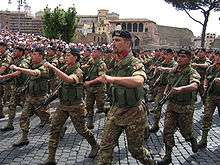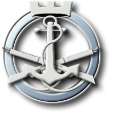Lagunari

.jpg)

_-_Caserma_Sant'Andrea.jpg)
The Lagunari (from the Italian "laguna" = lagoon) are amphibious troops of the Italian Army. Today's Reggimento Lagunari Serenissima amphibious assault regiment has its headquarters in Mestre, a borough of Venice, and in the present day they are still subordinate to the Pozzuolo del Friuli Cavalry Brigade. The lagunari tend to be a very mobile attack force, high-powered weaponry, and tactical skills. They are trained to attack from the water and to establish a beachhead, which is an area of control on foreign territory. They are Italian Army Marines.
Mission
During the Cold War, the regiment was stationed in the lagoon-rich south flank of the northeast Italian front. The Lagunari Regiment focused more on high intensity, conventional battlefields, such as those expected during the Cold War. Nowadays, its focus is on the more probable mid- and low intensity conflicts. The Lagunari have the ability to be projected to any hostile area around the globe due to their maneuverability. The Lagunari Regiment is versatile enough to be capable in conducting special operations under 'unconventional' methods while engaging on a 'conventional' battlefield. Today the Lagunari are intended for international missions, particularly in coastal regions and in areas rich in inland waterways.
The Lagunari Regiment is a littoral focused, amphibious, specialised light - medium force capable of deploying at short notice in support of the Italian military and diplomatic objectives overseas and are optimised for expeditionary warfare: operational situations requiring highly manoeuvrable, normally amphibious, forces. As the Italian Army' specialists in riverine operations the Regiment provides assets and expertise for these operations.
Organization and equipment
The regiment is structured as follows:
- Regimental Headquarters
- Command and Logistic Support Company
- Amphibious Tactical Support Company
- 1st Amphibious Battalion
- 1st Amphibious Assault Company
- 2nd Amphibious Assault Company
- 3rd Amphibious Assault Company
- 4th Mortar Company
- 5th Anti-tank Company
- Regimental Headquarters
The Amphibious Battalion is organized and equipped like an infantry battalions of the Italian Army with in addition amphibious combat vehicles (AAVs) and combat boats (rubber boats and rigid crafts). It fields Lince light multirole vehicles. The mortar company is equipped with 120mm Mortars, while the anti-tank company fields Spike anti-tank guided missile systems. The Amphibious Tactical Support Company ensures the amphibious capability of the regiment and is equipped with AAV7-A1 amphibious assault vehicles, landing boats and small speedboats. The Italian AAV7 Assault Amphibious Vehicle (AAV) is used as the Italian Lagunari primary amphibious platform to move Army Marines (and cargo) from military ship to shore. The Italian Lagunari use the AAV7 also for the shore to shore amphibious assault. The AAV7 uses a boat-like hull design and powerful water jets to make it one of the world's best amphibious assault vehicles.
Lagunari's RECON unit. The task of the Lagunari “Serenissima” Regiment RECON unit, is to accomplish shore reconnaissance, assault beaches shadowing, amphibious battle space shaping, deep ground reconnaissance and limited scale amphibious raids, in support of the regiment action. The main role of the RECON unit is to gather intelligence in support of operations. They also have a direct action function because are capable of independent action in support of the larger unit's mission. Lagunari’s RECON works usually focus on specific information requirements which cannot be obtained by other means:
- Amphibious reconnaissance;
- Beach/coastline reconnaissance;
- Raids and small boat operations;
- Deep reconnaissance;
- Direct action.
History
The Italian Lagunari (some times known as the 'Venetian Regiment') are the heirs to the embarked troops of the Republic of Venice. In 1964, the Head of the Italian Army entrusted to the "Serenissima" Lagunari Regiment the formal heritage of this centuries-old unit. The birth of the embarked troops of Venice goes back to the time of the fourth crusade when the Doge "Enrico Dandolo" put together one "Regiment " from ten companies distributed on the warships of the Venetian fleet, and then employed them in the two captures of Constantinople (Bisanzio - 1203/1204). The embarked troops of Venice had their final organisation in 1550 becoming the "Fanti da Mar" (Infantry of the sea) and they distinguished themselves during all the wars that the Republic of Venice fought against the Ottoman Empire, especially during the sieges of Famagosta and Candia, and in the great victory in the battle of Lepanto.
In 1951, the Italian army raised the Lagunari as an amphibious infantry unit. The Italian V Army Corps realized the need to secure its right flank against amphibious landings and due to the nature of the marshy tidal terrain and many small islands on the Northern Adriatic coast an amphibious unit was deemed the best answer to the needs of the Italian Army. Up to the army reform in 1975, the Lagunari Regiment consisted of three amphibious infantry and one tank battalion. Afterwards, it was reduced to two battalions: the amphibious infantry battalion "Serenissima" and the amphibious vehicles battalion "Sile" under the Amphibious Troops Command, which carried on the traditions of the regiment. The Amphibious Troops Command came under the Folgore Mechanized Division in 1975. When the Folgore was disbanded in 1986 the Command returned to the 5th Army Corps. In 1992, regiment was re-instituted and the two battalions merged into one. The regiment remained subordinate to the 5th Army Corps. Afterwards it came under the "Projection Forces Command" in Milan and later it joined the Pozzuolo del Friuli Brigade.
Today the Lagunari are intended for Army amphibious operation (shore to shore), riverine operations and international missions as specialized assault infantry. Plans to integrate the Lagunari into an amphibious brigade containing all Italian naval infantry, including the Navy's San Marco Marine Regiment failed in the 1990s, partly because of the distance between the respective bases: Venice and Brindisi.
In 2006, to establish closer cooperation between the two regiments, a Joint operations staff ("Forza Nazionale di Proiezione dal Mare") was established. The Italian Defense can fall back on the Army Lagunari and other support forces of the Army in cooperation with Navy units. The Navy San Marco unit can operate under Army control, if needed. Both organizations were used together for the first time, with support forces, in the UNIFIL operations after the 2006 Lebanon war as part of the Early Entry Force in September 2006: the Lagunari launched theirs AAVs from the Italian ship.
Italian Lagunari have long provided the Italian Armed Forces with a broad spectrum of response options when Italian and NATO interests have been threatened and in non-combat situations that require instant response to crisis. The Lagunari operates in rivers, bays, lagoons, across the littorals and ashore. The primary mission is to operate combat missions in the green water to shore and in the inland waters.
Until 2011 the Lagunari Regiment wore the black Army beret of the Italian Army with their own traditional and distinctive badge (anchor above two rifles). On returning from service in Afghanistan, they received a new beret in 'lagoon green' water color, retaining the same badge.
Main Operations Abroad
- Operation "Constant Forge" Sarajevo –BOSNIA (September – December 1998);
- Operation "Joint Guardian" Dakovica – KOSSOVO ( November 1999 – March 2000);
- Operation "Consistent Effort" Pec / Klina – KOSSOVO ( February – June 2001);
- Operation "Decisive Endeavour" Pec/Klina/Gorazdevac – KOSSOVO (2002-2003);
- Operation "Antica Babilonia" IRAQ ( June 2003 – March 2005);
- Operation "LEONTE" LEBANON ( August 2006 – April 2007);
- Operation "LEONTE 5" LEBANON ( August 2008 – April 2009);
- Operation "ISAF 15" AFGHANISTAN ( October 2010 – April 2011);
- Operation "LEONTE 14" LEBANON (May 2013 – October 2013);
See also
- Marines
- San Marco Regiment, marines of the Italian Navy.
External links
- Lagunari association Italian only


.jpg)
.jpg)

.jpg)
.jpg)
.jpg)
.jpg)
.jpg)
.jpg)
.jpg)